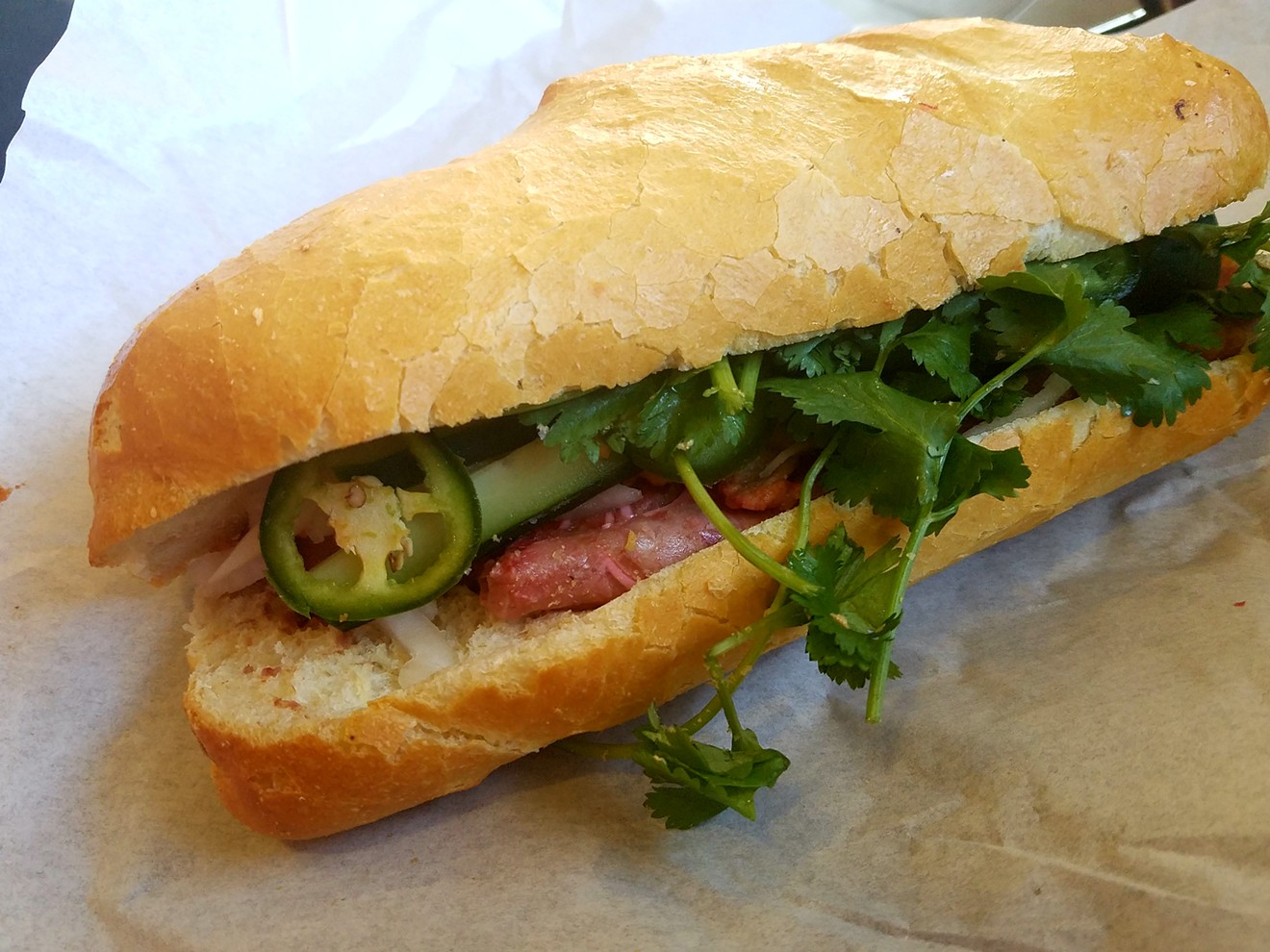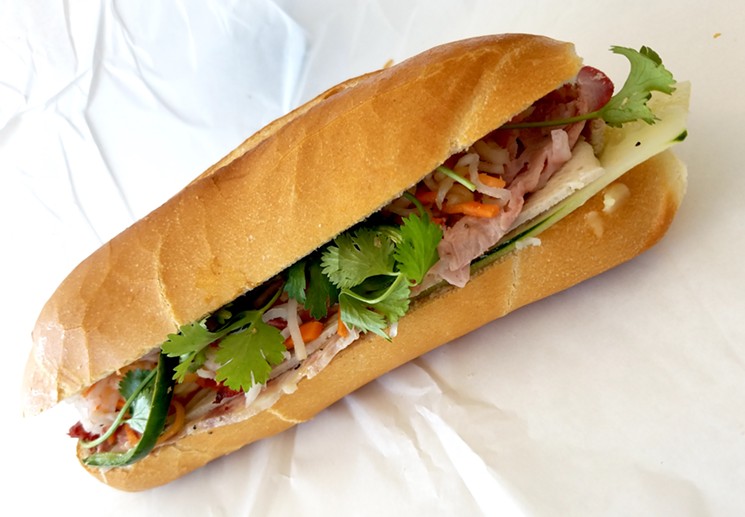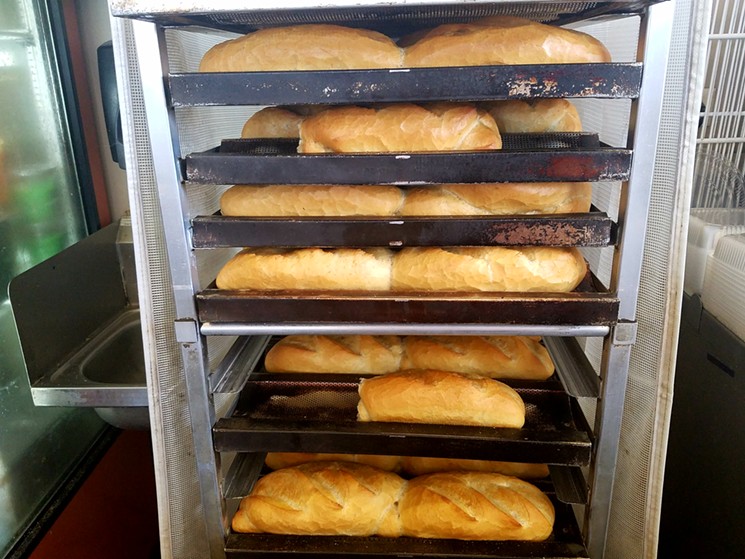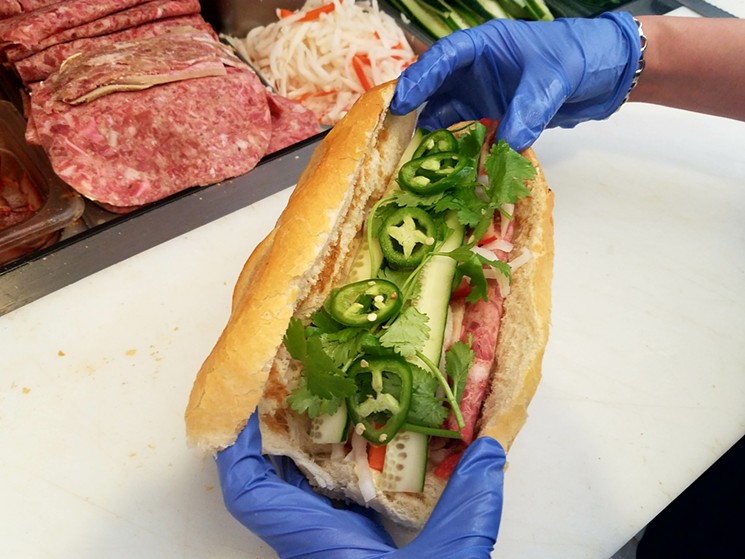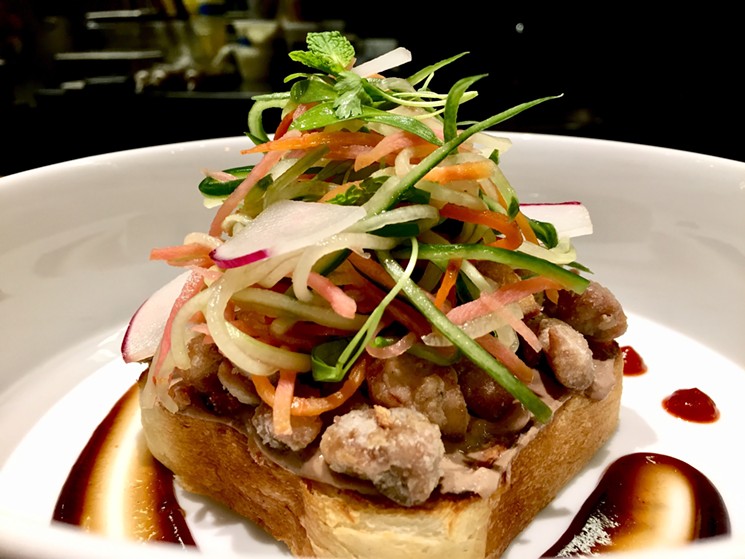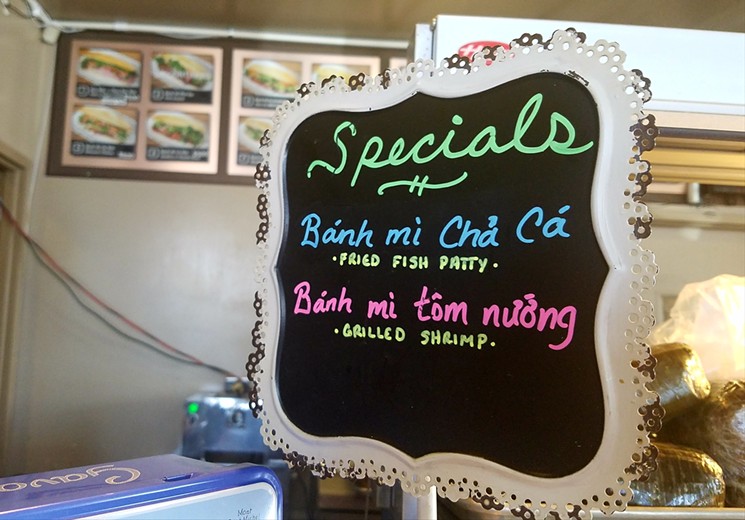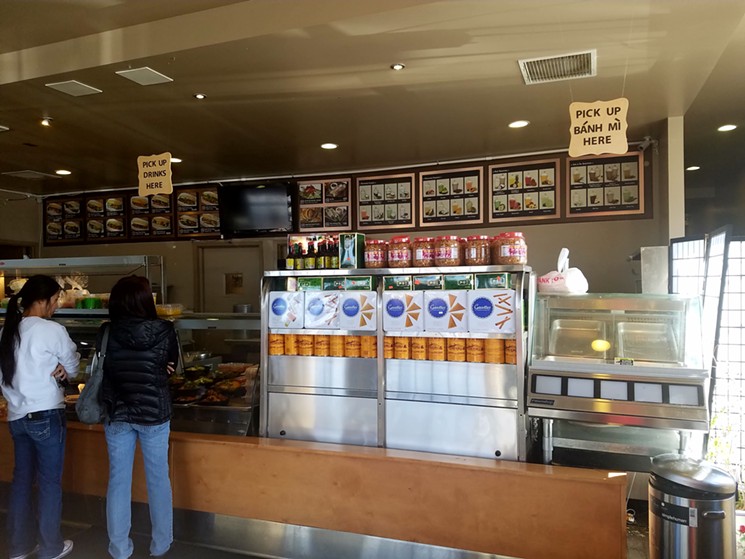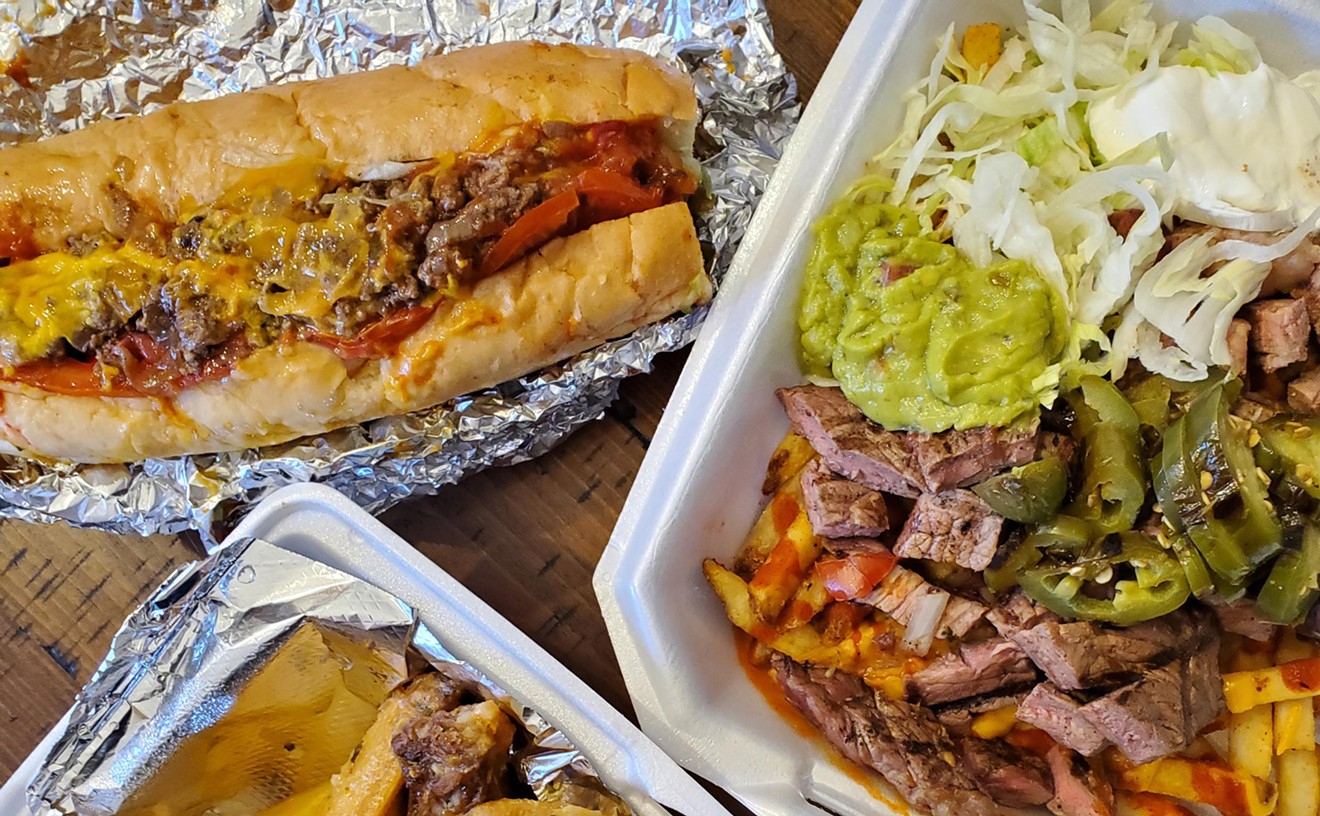When you offer a traditional sandwich like bánh mì and give it a modern twist, is it still considered bánh mì? In Denver you can find family-run shops that bake their own bread and create sandwiches much like you would find in Vietnam. But a number of chefs are also taking this tasty Vietnamese invention and giving it their own spin.
“Once the basic flavor palate has been established, it’s fun to play with variations,” says Duc Huynh of Vinh Xuong Bakery, one of Denver’s oldest Vietnamese bakeries. “I wouldn’t go as far as saying that your options are unlimited, but there is a decent bit of leeway. But there are some key components that need to remain a constant to stay true to the integrity of the bánh mì.”
The history of the bánh mì sandwich dates back to the 1950s. Created in Vietnam as street food, it’s a fusion of Vietnamese and French ingredients and techniques that came about during the French coloni-zation of the region. Many classic Gallic ingredients found their way into the markets and onto tables in Asia, so it was natural culinary evolution that the two cuisines would find a happy meeting point, espe-cially in bánh mì, which showcases the best of both worlds.
Traditionally, the sandwich starts with a short baguette that has been made with a mixture of rice and wheat flour. In fact, bánh mì is the Vietnamese word for “bread,” and the most common form of bread by far in Vietnam is the baguette. The mini-loaves get sliced and stuffed with a variety of in-gredients, from pork pâté to strips of grilled chicken to slabs of roasted pork belly. Then a refreshing dose of lightly pickled carrots, cucumber, daikon radish, sliced jalapeño and a pile of fresh cilantro are added. Altogether, you have a sandwich so good that it not only survived French colonialism, but is now found in America, where it made a debut in the mid-1970s, after the fall of Saigon.
At Vinh Xuong, the bánh mì hews close to the traditional standard, thanks to Huynh’s parents, who opened the original bakery almost thirty years ago (and before that worked at a family bakery in Viet-nam). The main component, says Huynh, is the bread.
“Some people think you can make bánh mì on any old hoagie roll, but the secret to a legit bánh mì is the French bread,” he says, adding that the bakery makes the rolls daily. “It must have a thin and but-tery crust on the outside and be fluffy and airy on the inside.”
You also need a pickle component, which classically consists of a slightly sweet, crunchy mix of julienned carrots and daikon radish.
“There can be some variations on this sour and bitter flavor, but the crisp texture is what is important,” says Huynh. “Pair that with the heat of chile peppers, cilantro, and then cool it off with a fresh cucumber, or something similar.”
This philosophy is what you will find in just about any restaurant that has taken on the sandwich. At Brider in LoHi, chef Chase Devitt has offered a Westernized bánh mì from the get-go.
“In general, alternative sandwiches are pretty hip right now, and it’s one of our best sellers,” says the chef, who makes it with the venue’s popular rotisserie chicken as well as pickled cucumbers and car-rots, fresh jalapeños, seasoned fish sauce, cilantro and mint. The sandwiches are made on baguettes from the Grateful Bread Company and are smeared with a chicken paté that Brider’s sister restaurants Acorn and Oak at Fourteenth in Boulder also employ.
At Jeff Osaka's 12@Madison in Congress Park, bánh mì has been on the menu for months. But instead of the classic roll, Osaka serves his on a slice of pullman loaf from Grateful Bread. He also incorporates fried sweetbreads as well as a slathering of chicken-liver mousse.
“Because of the French influence, the Vietnamese took the off cuts, so you will see brisket or ten-don,” says Osaka. “Using sweet breads isn’t that far off from the foundation of what their cuisine is.”
Osaka’s idea for this sandwich came from his recollection of getting a roasted-pork bánh mì from the Golden Deli Restaurant in Los Angeles, where he grew up. He dissected the dish and made it open-faced, which means the ingredients get piled high instead of being nicely nestled between baguette halves. And to help bring all those rich offal flavors together, the chef tops his sandwich with a healthy nest of pickled vegetables and fresh cilantro.
"Once those contrasting flavor combinations and textures exist, it gets really fun to try different proteins, veggies, marinades and spreads," says Huynh, who is opening an outpost of his bánh mì shop inside Zeppelin Station early this year. For example, as a special at Vinh Xuong Bakery, you can get the “pho-rench dip,” a sandwich featuring ingredients you would find in a bowl of pho — beef brisket, bean sprouts, Thai basil, cilantro and hoisin sauce — combined with bánh mì ingredients like cucumber, cilantro and jalapeño. The hefty construction is served with pho “au jus” dipping broth on the side.
Other places that have Westernized bánh mì include Olive & Finch (owned by chef Mary Nguyen, who has been gracing Denver with her Vietnamese and French cooking for years), which offers its "bun me" with house-roasted chicken, cucumbers, jalapeño, cilantro, romaine, pickled vegetables, garlic aioli and soy on a baguette that's more French than Vietnamese. At Mercantile Dining & Provision in Union Station, lunch-goers can get a bánh mì made with lemongrass pork paté, chile-glazed pork belly, pickled vegetables and chicken-liver aioli on a baguette. Then, on the more generic, everyman side, the casual eatery Zeps Epiq Sandwiches (a Quiznos spinoff) has a bánh mì with all the classic condiments and your choice of chicken, steak or lemongrass tofu. And for a completely vegan take on the sandwich, the bánh mì tacos at Vital Root in Berkeley do the original justice, even though they're made with edamame pâté, lemongrass tofu, pickled vegetables, cucumber, fresh herbs, jalapeño and sriracha aioli.
Keep in mind that while most modern places in Denver simply refer to the sandwich as bánh mì, you may see other variations that prove a little more descriptive. For example, bánh mì xíu mai (at Vinh Xuong) has pork meatballs; bánh mì xá xíu (at New Saigon Bakery & Deli) has barbecue pork; and bánh mì gà nuong (at traditional shops like Baker's Palace and Ba Le Sandwich) is stuffed with grilled chicken.
Even at the traditional bánh mì shops, you'll find variation based on French or Vietnamese influence. At New Saigon Bakery in Athmar Park, co-owner Thoa Nguyen says their baguettes are more French than Vietnamese.
“My grandpa worked for the French government before the Vietnam war, so he brought a lot of French influence into the family,” says Nguyen, who runs the restaurant with her sisters An and Thu. “Our recipe is made to be in between Vietnamese and French. We didn’t want a thin crust, like many of the surrounding shops, but we also didn’t want something too thick of a crust like the French baguette, either.”
The result is a bánh mì that tastes classic but has its own flavor profile — just going to show that no matter how you build your bánh mì, it tastes great in many forms.
[
{
"name": "Air - MediumRectangle - Inline Content - Mobile Display Size",
"component": "12017618",
"insertPoint": "2",
"requiredCountToDisplay": "2"
},{
"name": "Editor Picks",
"component": "17242653",
"insertPoint": "4",
"requiredCountToDisplay": "1"
},{
"name": "Inline Links",
"component": "18838239",
"insertPoint": "8th",
"startingPoint": 8,
"requiredCountToDisplay": "7",
"maxInsertions": 25
},{
"name": "Air - MediumRectangle - Combo - Inline Content",
"component": "17261320",
"insertPoint": "8th",
"startingPoint": 8,
"requiredCountToDisplay": "7",
"maxInsertions": 25
},{
"name": "Inline Links",
"component": "18838239",
"insertPoint": "8th",
"startingPoint": 12,
"requiredCountToDisplay": "11",
"maxInsertions": 25
},{
"name": "Air - Leaderboard Tower - Combo - Inline Content",
"component": "17261321",
"insertPoint": "8th",
"startingPoint": 12,
"requiredCountToDisplay": "11",
"maxInsertions": 25
}
]

